Management Accounting Report: Jeffrey & Son's Ltd Analysis
VerifiedAdded on 2020/01/28
|21
|5954
|97
Report
AI Summary
This management accounting report analyzes various costing techniques and budgeting processes using the case of Jeffrey & Son's Ltd. It covers different types of cost classification, including material, labor, and overhead, as well as direct and indirect costs. The report calculates job costs using the job costing method and determines costs using absorption costing. It also prepares and analyzes routine cost reports, applying performance indicators to identify areas for improvement and recommending cost reduction and value enhancement strategies. Furthermore, the report explains the purpose and nature of the budgeting process, selects appropriate budgeting methods, and prepares production, material purchase, and cash budgets. Finally, it computes variances, identifies possible causes, and provides recommendations for corrective actions, along with a reconciliation operating statement and a management report.
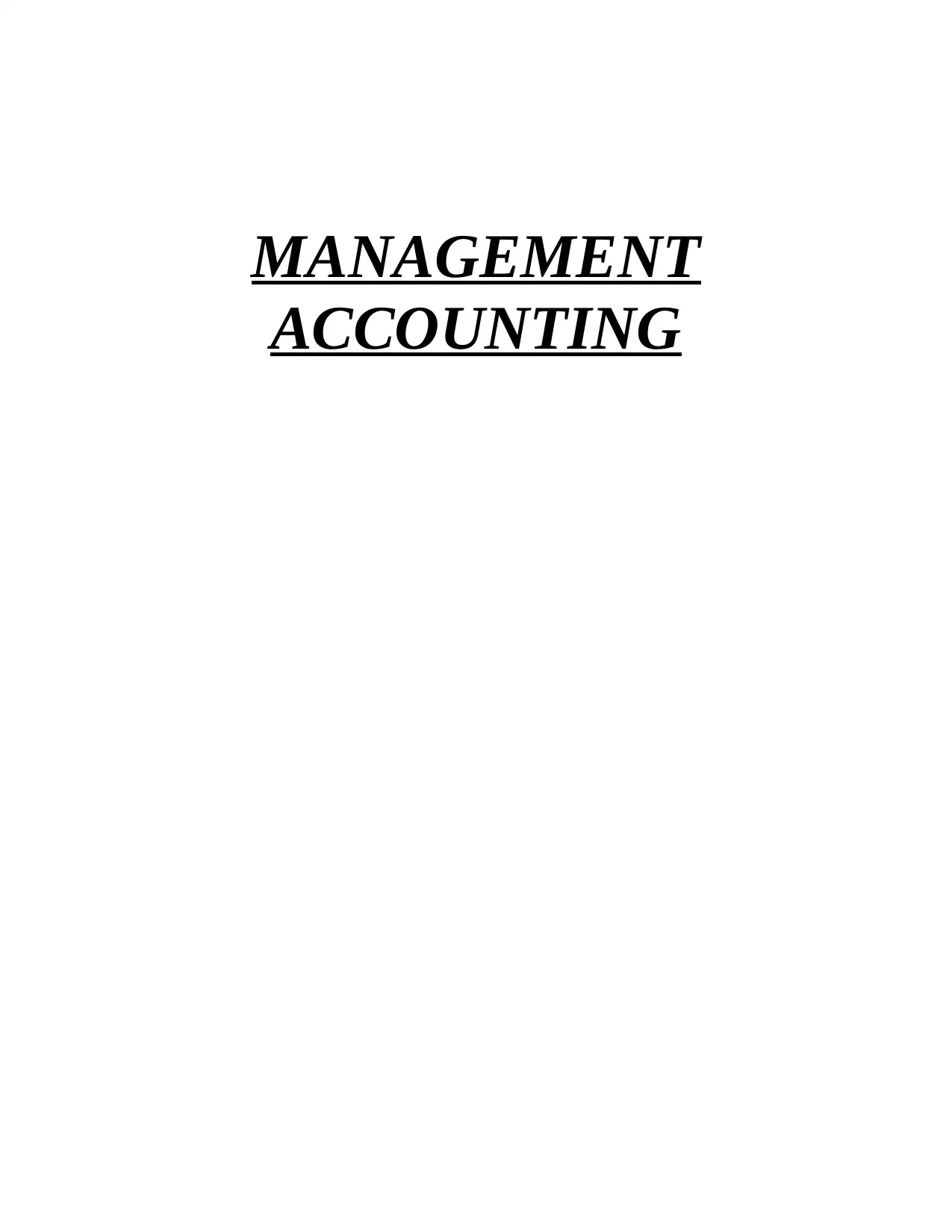
MANAGEMENT
ACCOUNTING
ACCOUNTING
Paraphrase This Document
Need a fresh take? Get an instant paraphrase of this document with our AI Paraphraser
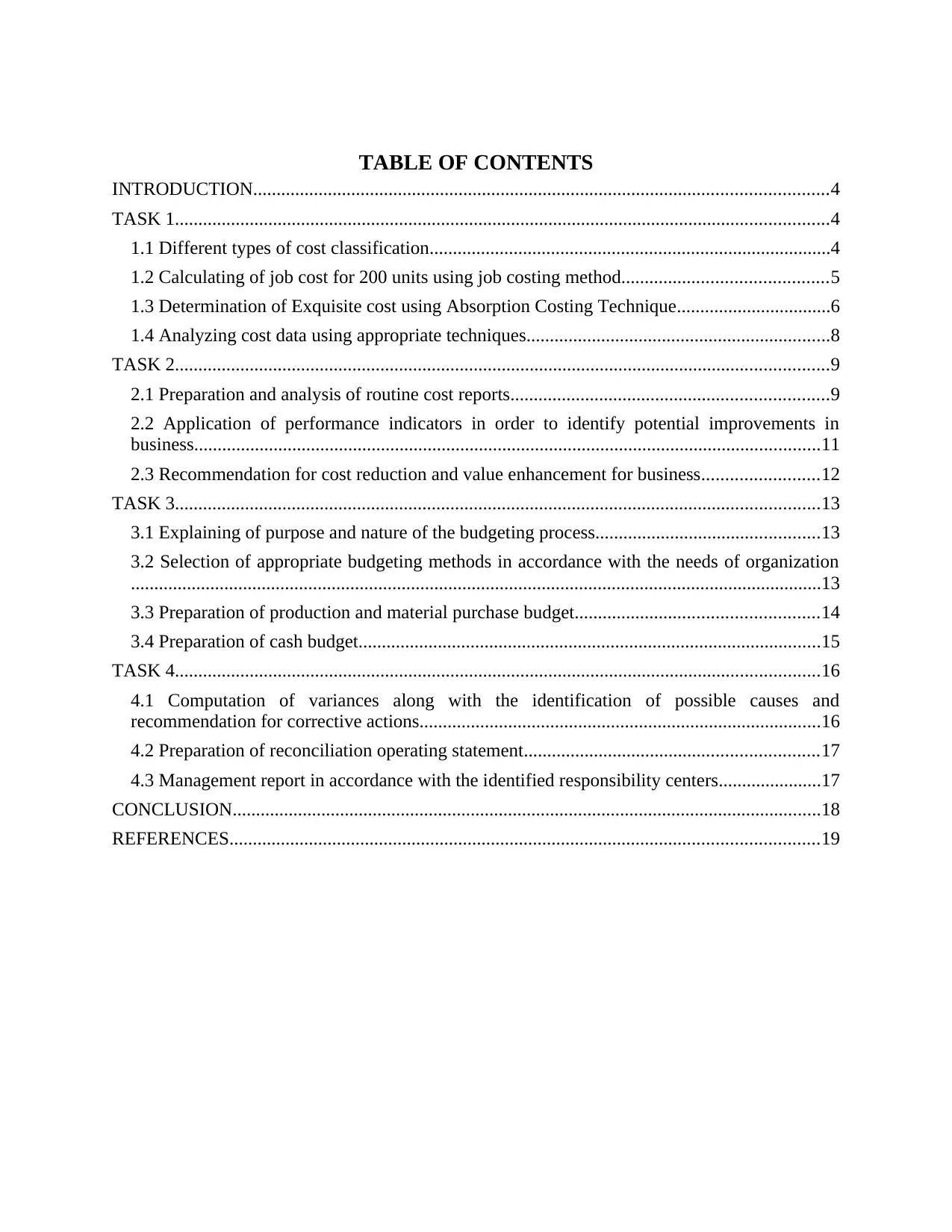
TABLE OF CONTENTS
INTRODUCTION...........................................................................................................................4
TASK 1............................................................................................................................................4
1.1 Different types of cost classification......................................................................................4
1.2 Calculating of job cost for 200 units using job costing method............................................5
1.3 Determination of Exquisite cost using Absorption Costing Technique.................................6
1.4 Analyzing cost data using appropriate techniques.................................................................8
TASK 2............................................................................................................................................9
2.1 Preparation and analysis of routine cost reports....................................................................9
2.2 Application of performance indicators in order to identify potential improvements in
business......................................................................................................................................11
2.3 Recommendation for cost reduction and value enhancement for business.........................12
TASK 3..........................................................................................................................................13
3.1 Explaining of purpose and nature of the budgeting process................................................13
3.2 Selection of appropriate budgeting methods in accordance with the needs of organization
....................................................................................................................................................13
3.3 Preparation of production and material purchase budget....................................................14
3.4 Preparation of cash budget...................................................................................................15
TASK 4..........................................................................................................................................16
4.1 Computation of variances along with the identification of possible causes and
recommendation for corrective actions......................................................................................16
4.2 Preparation of reconciliation operating statement...............................................................17
4.3 Management report in accordance with the identified responsibility centers......................17
CONCLUSION..............................................................................................................................18
REFERENCES..............................................................................................................................19
INTRODUCTION...........................................................................................................................4
TASK 1............................................................................................................................................4
1.1 Different types of cost classification......................................................................................4
1.2 Calculating of job cost for 200 units using job costing method............................................5
1.3 Determination of Exquisite cost using Absorption Costing Technique.................................6
1.4 Analyzing cost data using appropriate techniques.................................................................8
TASK 2............................................................................................................................................9
2.1 Preparation and analysis of routine cost reports....................................................................9
2.2 Application of performance indicators in order to identify potential improvements in
business......................................................................................................................................11
2.3 Recommendation for cost reduction and value enhancement for business.........................12
TASK 3..........................................................................................................................................13
3.1 Explaining of purpose and nature of the budgeting process................................................13
3.2 Selection of appropriate budgeting methods in accordance with the needs of organization
....................................................................................................................................................13
3.3 Preparation of production and material purchase budget....................................................14
3.4 Preparation of cash budget...................................................................................................15
TASK 4..........................................................................................................................................16
4.1 Computation of variances along with the identification of possible causes and
recommendation for corrective actions......................................................................................16
4.2 Preparation of reconciliation operating statement...............................................................17
4.3 Management report in accordance with the identified responsibility centers......................17
CONCLUSION..............................................................................................................................18
REFERENCES..............................................................................................................................19
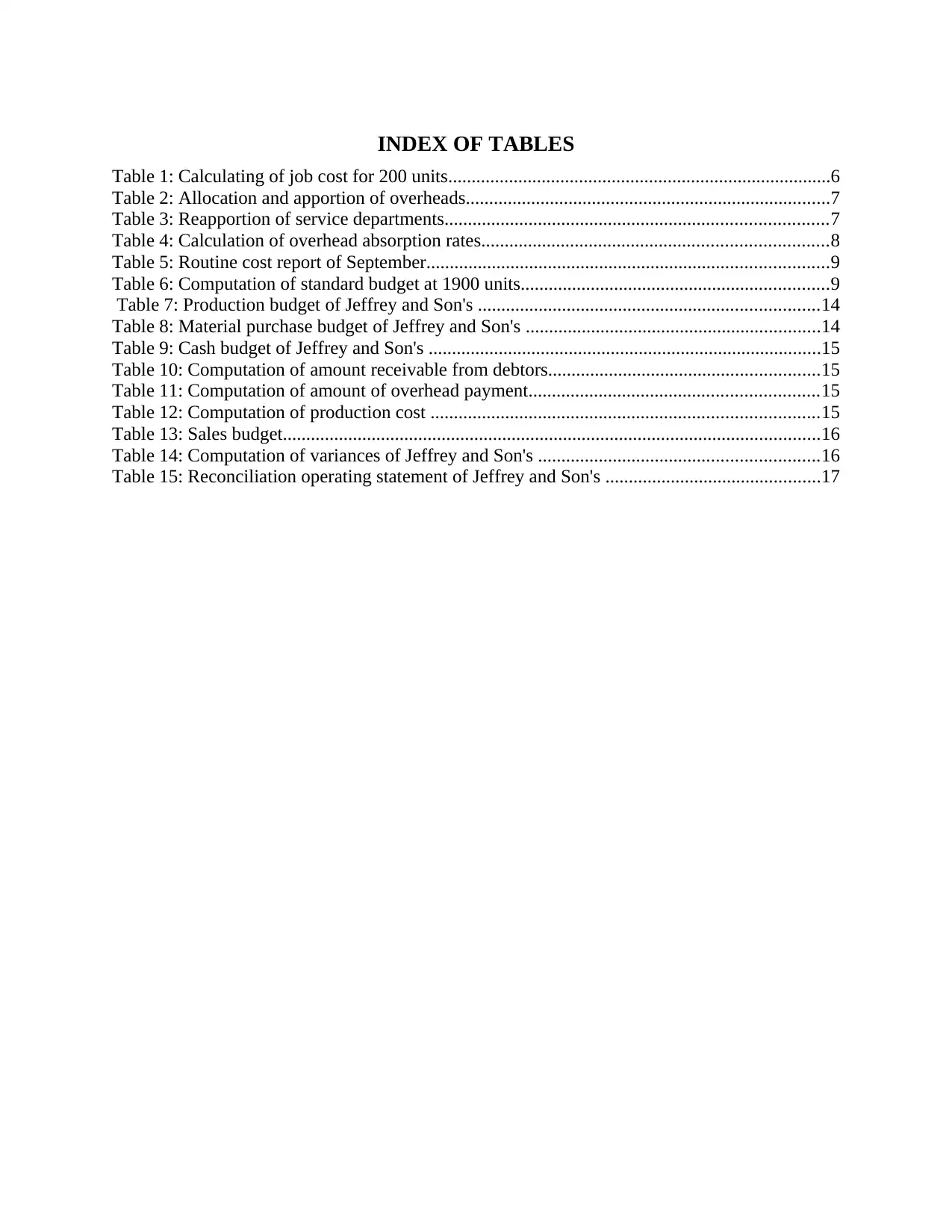
INDEX OF TABLES
Table 1: Calculating of job cost for 200 units..................................................................................6
Table 2: Allocation and apportion of overheads..............................................................................7
Table 3: Reapportion of service departments..................................................................................7
Table 4: Calculation of overhead absorption rates..........................................................................8
Table 5: Routine cost report of September......................................................................................9
Table 6: Computation of standard budget at 1900 units..................................................................9
Table 7: Production budget of Jeffrey and Son's .........................................................................14
Table 8: Material purchase budget of Jeffrey and Son's ...............................................................14
Table 9: Cash budget of Jeffrey and Son's ....................................................................................15
Table 10: Computation of amount receivable from debtors..........................................................15
Table 11: Computation of amount of overhead payment..............................................................15
Table 12: Computation of production cost ...................................................................................15
Table 13: Sales budget...................................................................................................................16
Table 14: Computation of variances of Jeffrey and Son's ............................................................16
Table 15: Reconciliation operating statement of Jeffrey and Son's ..............................................17
Table 1: Calculating of job cost for 200 units..................................................................................6
Table 2: Allocation and apportion of overheads..............................................................................7
Table 3: Reapportion of service departments..................................................................................7
Table 4: Calculation of overhead absorption rates..........................................................................8
Table 5: Routine cost report of September......................................................................................9
Table 6: Computation of standard budget at 1900 units..................................................................9
Table 7: Production budget of Jeffrey and Son's .........................................................................14
Table 8: Material purchase budget of Jeffrey and Son's ...............................................................14
Table 9: Cash budget of Jeffrey and Son's ....................................................................................15
Table 10: Computation of amount receivable from debtors..........................................................15
Table 11: Computation of amount of overhead payment..............................................................15
Table 12: Computation of production cost ...................................................................................15
Table 13: Sales budget...................................................................................................................16
Table 14: Computation of variances of Jeffrey and Son's ............................................................16
Table 15: Reconciliation operating statement of Jeffrey and Son's ..............................................17
⊘ This is a preview!⊘
Do you want full access?
Subscribe today to unlock all pages.

Trusted by 1+ million students worldwide
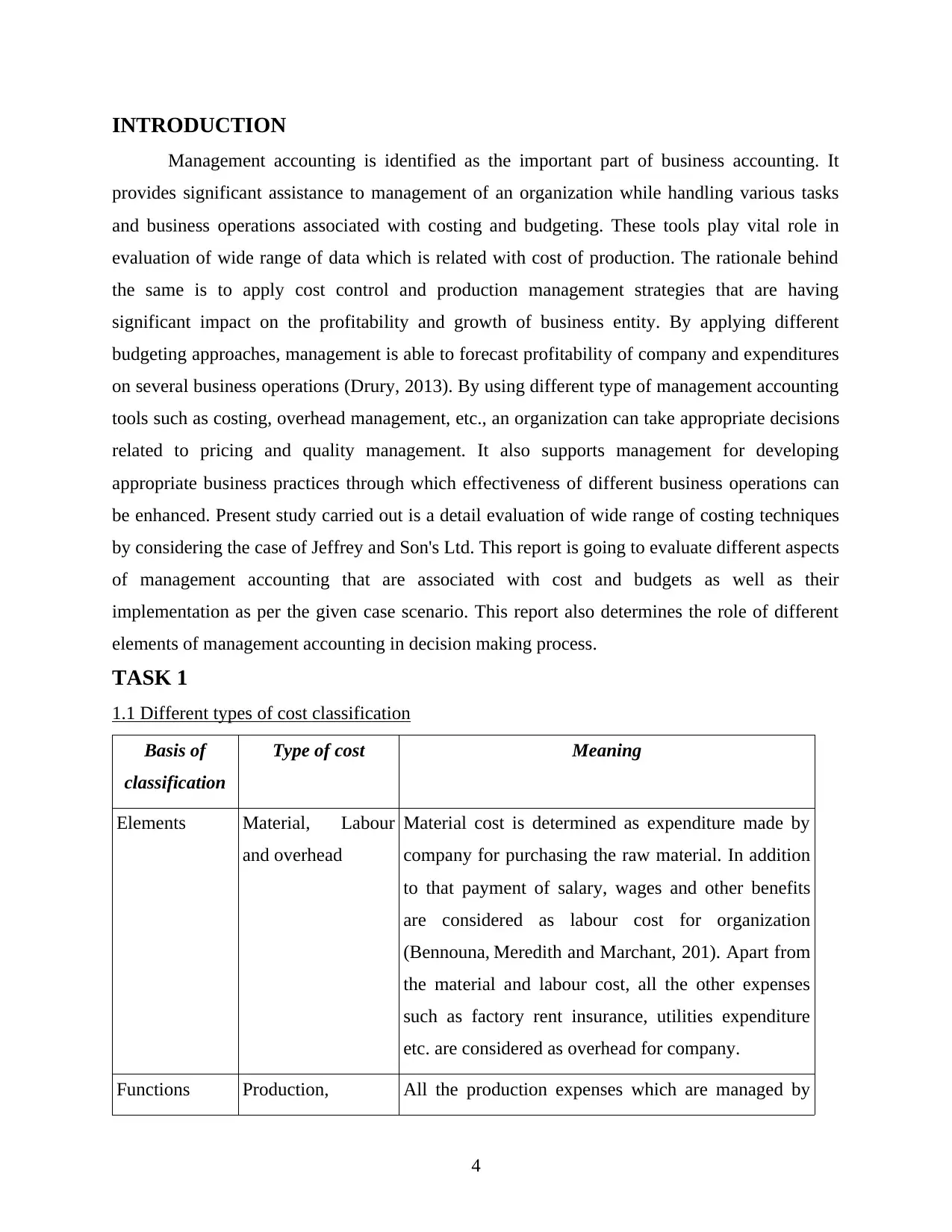
INTRODUCTION
Management accounting is identified as the important part of business accounting. It
provides significant assistance to management of an organization while handling various tasks
and business operations associated with costing and budgeting. These tools play vital role in
evaluation of wide range of data which is related with cost of production. The rationale behind
the same is to apply cost control and production management strategies that are having
significant impact on the profitability and growth of business entity. By applying different
budgeting approaches, management is able to forecast profitability of company and expenditures
on several business operations (Drury, 2013). By using different type of management accounting
tools such as costing, overhead management, etc., an organization can take appropriate decisions
related to pricing and quality management. It also supports management for developing
appropriate business practices through which effectiveness of different business operations can
be enhanced. Present study carried out is a detail evaluation of wide range of costing techniques
by considering the case of Jeffrey and Son's Ltd. This report is going to evaluate different aspects
of management accounting that are associated with cost and budgets as well as their
implementation as per the given case scenario. This report also determines the role of different
elements of management accounting in decision making process.
TASK 1
1.1 Different types of cost classification
Basis of
classification
Type of cost Meaning
Elements Material, Labour
and overhead
Material cost is determined as expenditure made by
company for purchasing the raw material. In addition
to that payment of salary, wages and other benefits
are considered as labour cost for organization
(Bennouna, Meredith and Marchant, 201). Apart from
the material and labour cost, all the other expenses
such as factory rent insurance, utilities expenditure
etc. are considered as overhead for company.
Functions Production, All the production expenses which are managed by
4
Management accounting is identified as the important part of business accounting. It
provides significant assistance to management of an organization while handling various tasks
and business operations associated with costing and budgeting. These tools play vital role in
evaluation of wide range of data which is related with cost of production. The rationale behind
the same is to apply cost control and production management strategies that are having
significant impact on the profitability and growth of business entity. By applying different
budgeting approaches, management is able to forecast profitability of company and expenditures
on several business operations (Drury, 2013). By using different type of management accounting
tools such as costing, overhead management, etc., an organization can take appropriate decisions
related to pricing and quality management. It also supports management for developing
appropriate business practices through which effectiveness of different business operations can
be enhanced. Present study carried out is a detail evaluation of wide range of costing techniques
by considering the case of Jeffrey and Son's Ltd. This report is going to evaluate different aspects
of management accounting that are associated with cost and budgets as well as their
implementation as per the given case scenario. This report also determines the role of different
elements of management accounting in decision making process.
TASK 1
1.1 Different types of cost classification
Basis of
classification
Type of cost Meaning
Elements Material, Labour
and overhead
Material cost is determined as expenditure made by
company for purchasing the raw material. In addition
to that payment of salary, wages and other benefits
are considered as labour cost for organization
(Bennouna, Meredith and Marchant, 201). Apart from
the material and labour cost, all the other expenses
such as factory rent insurance, utilities expenditure
etc. are considered as overhead for company.
Functions Production, All the production expenses which are managed by
4
Paraphrase This Document
Need a fresh take? Get an instant paraphrase of this document with our AI Paraphraser
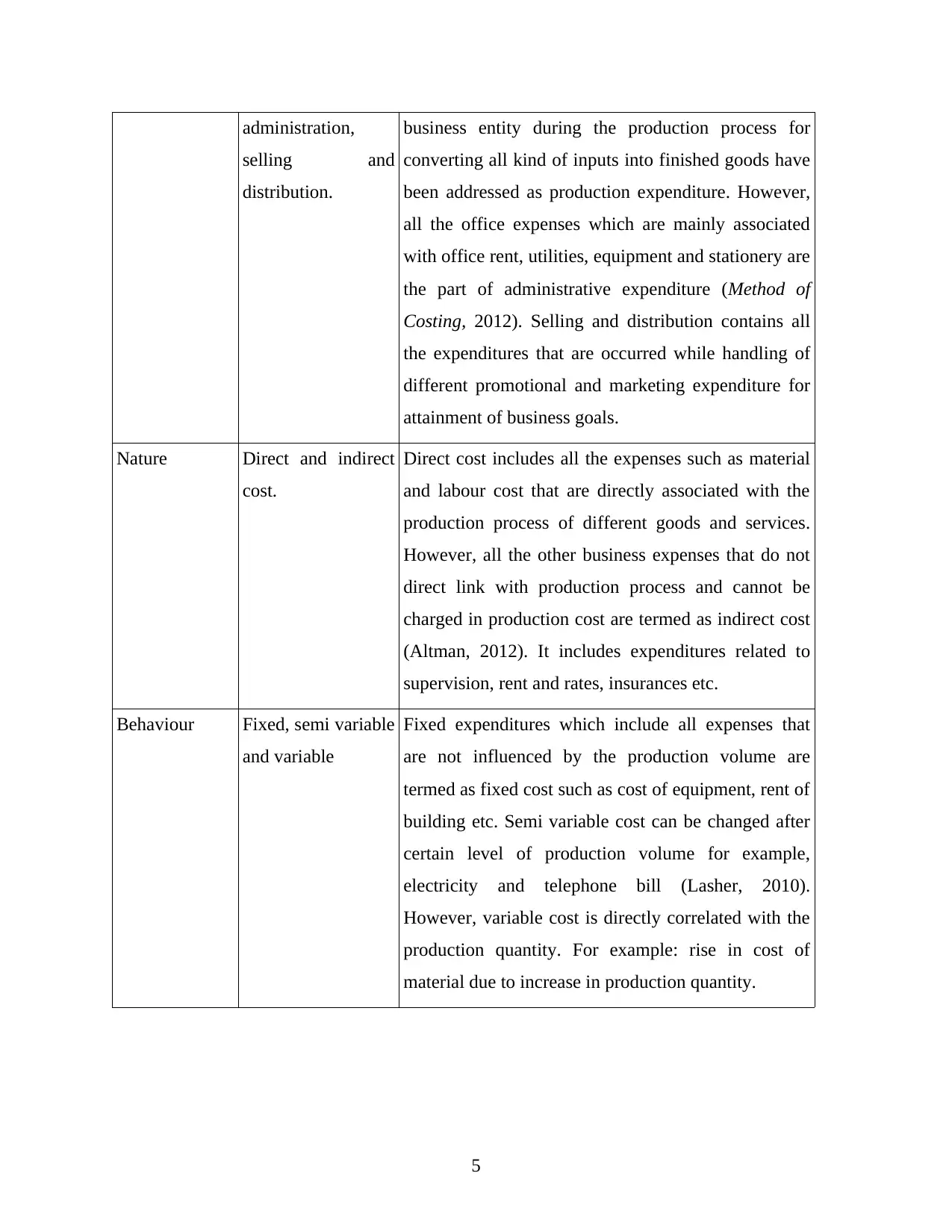
administration,
selling and
distribution.
business entity during the production process for
converting all kind of inputs into finished goods have
been addressed as production expenditure. However,
all the office expenses which are mainly associated
with office rent, utilities, equipment and stationery are
the part of administrative expenditure (Method of
Costing, 2012). Selling and distribution contains all
the expenditures that are occurred while handling of
different promotional and marketing expenditure for
attainment of business goals.
Nature Direct and indirect
cost.
Direct cost includes all the expenses such as material
and labour cost that are directly associated with the
production process of different goods and services.
However, all the other business expenses that do not
direct link with production process and cannot be
charged in production cost are termed as indirect cost
(Altman, 2012). It includes expenditures related to
supervision, rent and rates, insurances etc.
Behaviour Fixed, semi variable
and variable
Fixed expenditures which include all expenses that
are not influenced by the production volume are
termed as fixed cost such as cost of equipment, rent of
building etc. Semi variable cost can be changed after
certain level of production volume for example,
electricity and telephone bill (Lasher, 2010).
However, variable cost is directly correlated with the
production quantity. For example: rise in cost of
material due to increase in production quantity.
5
selling and
distribution.
business entity during the production process for
converting all kind of inputs into finished goods have
been addressed as production expenditure. However,
all the office expenses which are mainly associated
with office rent, utilities, equipment and stationery are
the part of administrative expenditure (Method of
Costing, 2012). Selling and distribution contains all
the expenditures that are occurred while handling of
different promotional and marketing expenditure for
attainment of business goals.
Nature Direct and indirect
cost.
Direct cost includes all the expenses such as material
and labour cost that are directly associated with the
production process of different goods and services.
However, all the other business expenses that do not
direct link with production process and cannot be
charged in production cost are termed as indirect cost
(Altman, 2012). It includes expenditures related to
supervision, rent and rates, insurances etc.
Behaviour Fixed, semi variable
and variable
Fixed expenditures which include all expenses that
are not influenced by the production volume are
termed as fixed cost such as cost of equipment, rent of
building etc. Semi variable cost can be changed after
certain level of production volume for example,
electricity and telephone bill (Lasher, 2010).
However, variable cost is directly correlated with the
production quantity. For example: rise in cost of
material due to increase in production quantity.
5
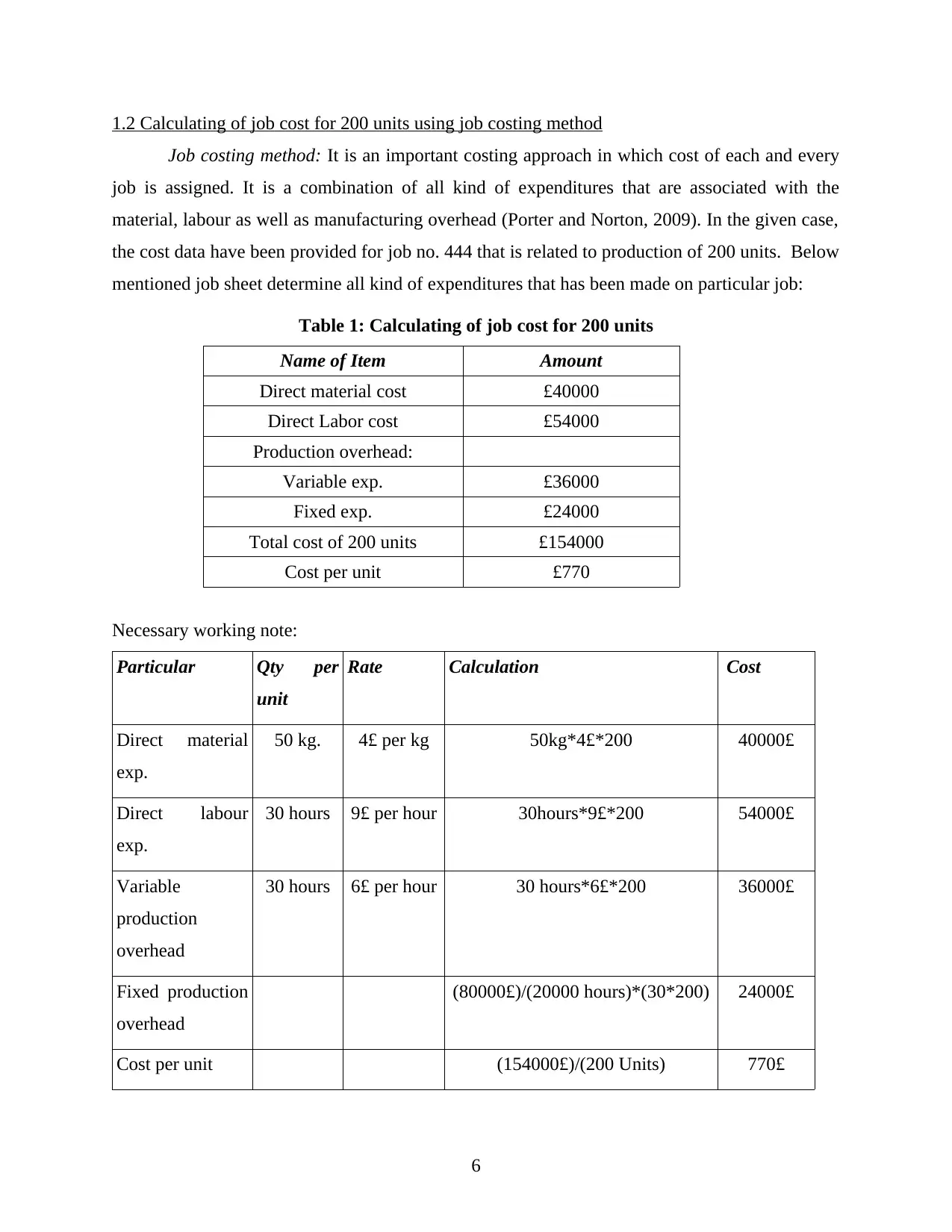
1.2 Calculating of job cost for 200 units using job costing method
Job costing method: It is an important costing approach in which cost of each and every
job is assigned. It is a combination of all kind of expenditures that are associated with the
material, labour as well as manufacturing overhead (Porter and Norton, 2009). In the given case,
the cost data have been provided for job no. 444 that is related to production of 200 units. Below
mentioned job sheet determine all kind of expenditures that has been made on particular job:
Table 1: Calculating of job cost for 200 units
Name of Item Amount
Direct material cost £40000
Direct Labor cost £54000
Production overhead:
Variable exp. £36000
Fixed exp. £24000
Total cost of 200 units £154000
Cost per unit £770
Necessary working note:
Particular Qty per
unit
Rate Calculation Cost
Direct material
exp.
50 kg. 4£ per kg 50kg*4£*200 40000£
Direct labour
exp.
30 hours 9£ per hour 30hours*9£*200 54000£
Variable
production
overhead
30 hours 6£ per hour 30 hours*6£*200 36000£
Fixed production
overhead
(80000£)/(20000 hours)*(30*200) 24000£
Cost per unit (154000£)/(200 Units) 770£
6
Job costing method: It is an important costing approach in which cost of each and every
job is assigned. It is a combination of all kind of expenditures that are associated with the
material, labour as well as manufacturing overhead (Porter and Norton, 2009). In the given case,
the cost data have been provided for job no. 444 that is related to production of 200 units. Below
mentioned job sheet determine all kind of expenditures that has been made on particular job:
Table 1: Calculating of job cost for 200 units
Name of Item Amount
Direct material cost £40000
Direct Labor cost £54000
Production overhead:
Variable exp. £36000
Fixed exp. £24000
Total cost of 200 units £154000
Cost per unit £770
Necessary working note:
Particular Qty per
unit
Rate Calculation Cost
Direct material
exp.
50 kg. 4£ per kg 50kg*4£*200 40000£
Direct labour
exp.
30 hours 9£ per hour 30hours*9£*200 54000£
Variable
production
overhead
30 hours 6£ per hour 30 hours*6£*200 36000£
Fixed production
overhead
(80000£)/(20000 hours)*(30*200) 24000£
Cost per unit (154000£)/(200 Units) 770£
6
⊘ This is a preview!⊘
Do you want full access?
Subscribe today to unlock all pages.

Trusted by 1+ million students worldwide
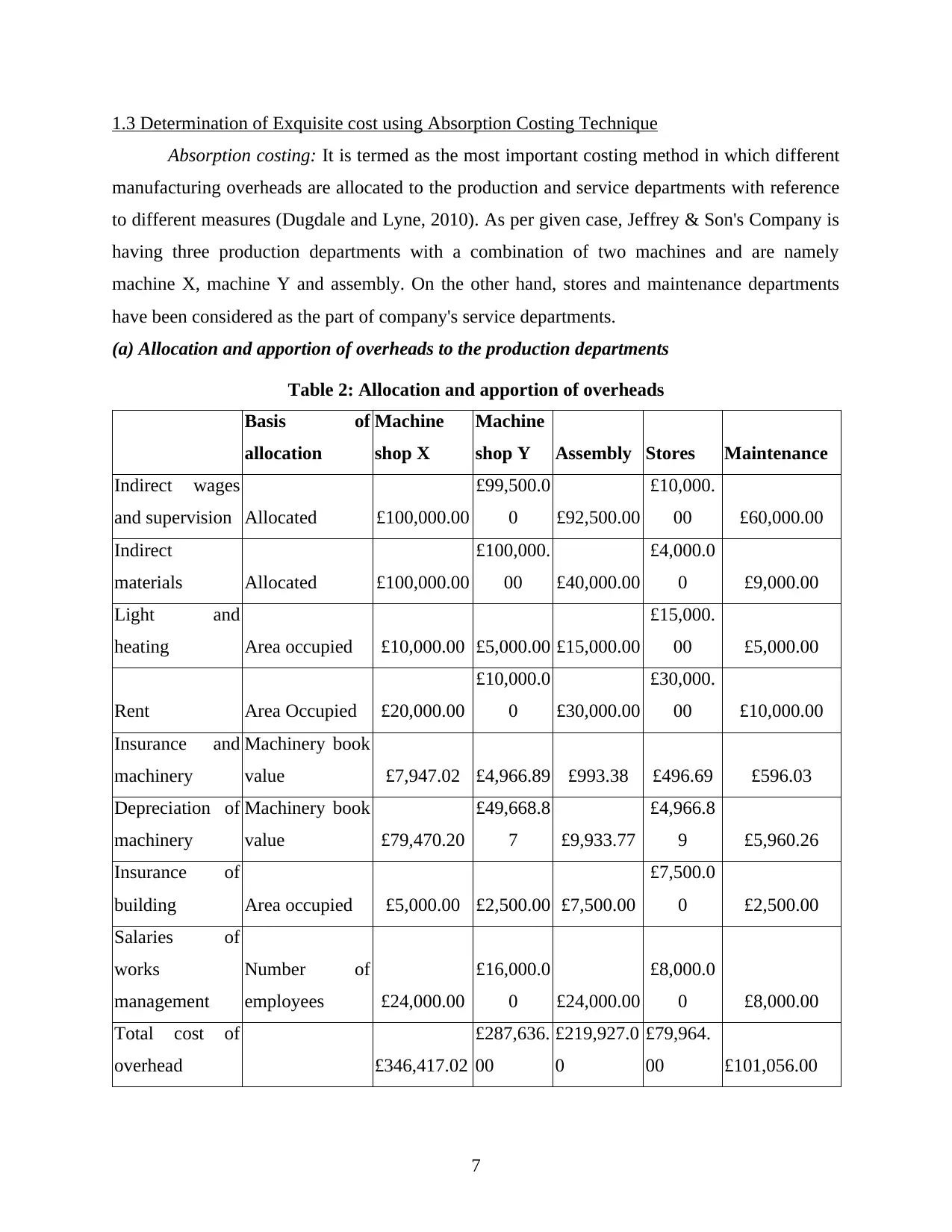
1.3 Determination of Exquisite cost using Absorption Costing Technique
Absorption costing: It is termed as the most important costing method in which different
manufacturing overheads are allocated to the production and service departments with reference
to different measures (Dugdale and Lyne, 2010). As per given case, Jeffrey & Son's Company is
having three production departments with a combination of two machines and are namely
machine X, machine Y and assembly. On the other hand, stores and maintenance departments
have been considered as the part of company's service departments.
(a) Allocation and apportion of overheads to the production departments
Table 2: Allocation and apportion of overheads
Basis of
allocation
Machine
shop X
Machine
shop Y Assembly Stores Maintenance
Indirect wages
and supervision Allocated £100,000.00
£99,500.0
0 £92,500.00
£10,000.
00 £60,000.00
Indirect
materials Allocated £100,000.00
£100,000.
00 £40,000.00
£4,000.0
0 £9,000.00
Light and
heating Area occupied £10,000.00 £5,000.00 £15,000.00
£15,000.
00 £5,000.00
Rent Area Occupied £20,000.00
£10,000.0
0 £30,000.00
£30,000.
00 £10,000.00
Insurance and
machinery
Machinery book
value £7,947.02 £4,966.89 £993.38 £496.69 £596.03
Depreciation of
machinery
Machinery book
value £79,470.20
£49,668.8
7 £9,933.77
£4,966.8
9 £5,960.26
Insurance of
building Area occupied £5,000.00 £2,500.00 £7,500.00
£7,500.0
0 £2,500.00
Salaries of
works
management
Number of
employees £24,000.00
£16,000.0
0 £24,000.00
£8,000.0
0 £8,000.00
Total cost of
overhead £346,417.02
£287,636.
00
£219,927.0
0
£79,964.
00 £101,056.00
7
Absorption costing: It is termed as the most important costing method in which different
manufacturing overheads are allocated to the production and service departments with reference
to different measures (Dugdale and Lyne, 2010). As per given case, Jeffrey & Son's Company is
having three production departments with a combination of two machines and are namely
machine X, machine Y and assembly. On the other hand, stores and maintenance departments
have been considered as the part of company's service departments.
(a) Allocation and apportion of overheads to the production departments
Table 2: Allocation and apportion of overheads
Basis of
allocation
Machine
shop X
Machine
shop Y Assembly Stores Maintenance
Indirect wages
and supervision Allocated £100,000.00
£99,500.0
0 £92,500.00
£10,000.
00 £60,000.00
Indirect
materials Allocated £100,000.00
£100,000.
00 £40,000.00
£4,000.0
0 £9,000.00
Light and
heating Area occupied £10,000.00 £5,000.00 £15,000.00
£15,000.
00 £5,000.00
Rent Area Occupied £20,000.00
£10,000.0
0 £30,000.00
£30,000.
00 £10,000.00
Insurance and
machinery
Machinery book
value £7,947.02 £4,966.89 £993.38 £496.69 £596.03
Depreciation of
machinery
Machinery book
value £79,470.20
£49,668.8
7 £9,933.77
£4,966.8
9 £5,960.26
Insurance of
building Area occupied £5,000.00 £2,500.00 £7,500.00
£7,500.0
0 £2,500.00
Salaries of
works
management
Number of
employees £24,000.00
£16,000.0
0 £24,000.00
£8,000.0
0 £8,000.00
Total cost of
overhead £346,417.02
£287,636.
00
£219,927.0
0
£79,964.
00 £101,056.00
7
Paraphrase This Document
Need a fresh take? Get an instant paraphrase of this document with our AI Paraphraser
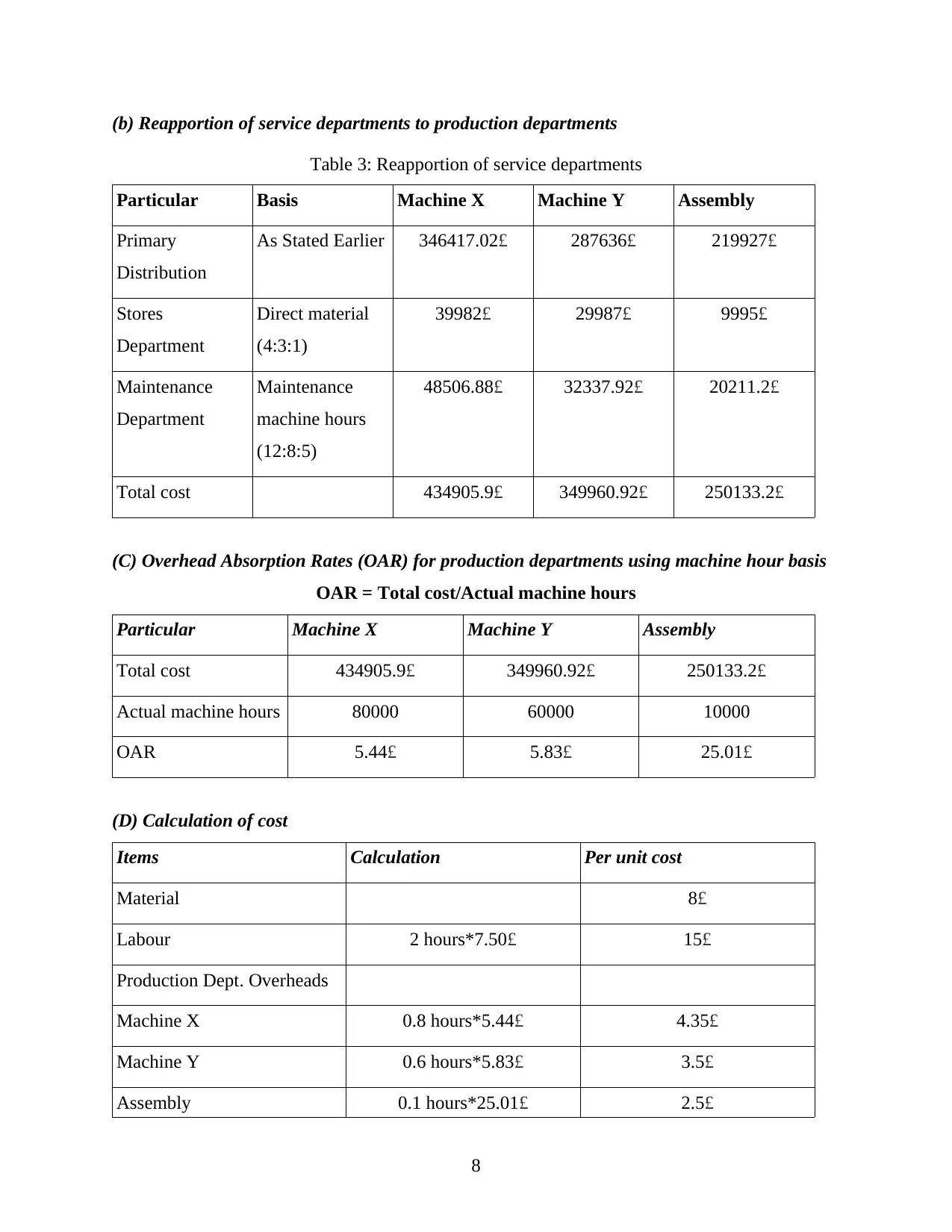
(b) Reapportion of service departments to production departments
Table 3: Reapportion of service departments
Particular Basis Machine X Machine Y Assembly
Primary
Distribution
As Stated Earlier 346417.02£ 287636£ 219927£
Stores
Department
Direct material
(4:3:1)
39982£ 29987£ 9995£
Maintenance
Department
Maintenance
machine hours
(12:8:5)
48506.88£ 32337.92£ 20211.2£
Total cost 434905.9£ 349960.92£ 250133.2£
(C) Overhead Absorption Rates (OAR) for production departments using machine hour basis
OAR = Total cost/Actual machine hours
Particular Machine X Machine Y Assembly
Total cost 434905.9£ 349960.92£ 250133.2£
Actual machine hours 80000 60000 10000
OAR 5.44£ 5.83£ 25.01£
(D) Calculation of cost
Items Calculation Per unit cost
Material 8£
Labour 2 hours*7.50£ 15£
Production Dept. Overheads
Machine X 0.8 hours*5.44£ 4.35£
Machine Y 0.6 hours*5.83£ 3.5£
Assembly 0.1 hours*25.01£ 2.5£
8
Table 3: Reapportion of service departments
Particular Basis Machine X Machine Y Assembly
Primary
Distribution
As Stated Earlier 346417.02£ 287636£ 219927£
Stores
Department
Direct material
(4:3:1)
39982£ 29987£ 9995£
Maintenance
Department
Maintenance
machine hours
(12:8:5)
48506.88£ 32337.92£ 20211.2£
Total cost 434905.9£ 349960.92£ 250133.2£
(C) Overhead Absorption Rates (OAR) for production departments using machine hour basis
OAR = Total cost/Actual machine hours
Particular Machine X Machine Y Assembly
Total cost 434905.9£ 349960.92£ 250133.2£
Actual machine hours 80000 60000 10000
OAR 5.44£ 5.83£ 25.01£
(D) Calculation of cost
Items Calculation Per unit cost
Material 8£
Labour 2 hours*7.50£ 15£
Production Dept. Overheads
Machine X 0.8 hours*5.44£ 4.35£
Machine Y 0.6 hours*5.83£ 3.5£
Assembly 0.1 hours*25.01£ 2.5£
8
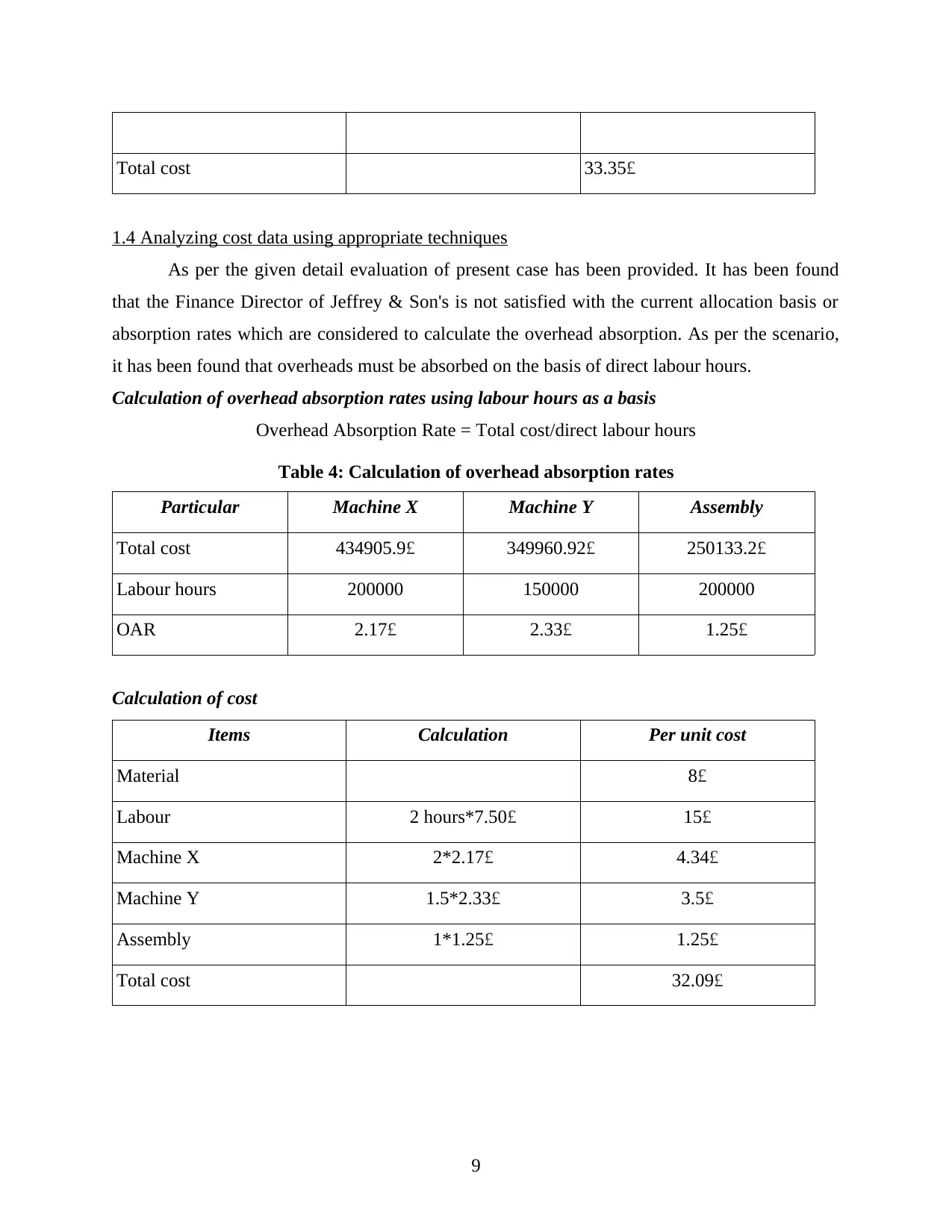
Total cost 33.35£
1.4 Analyzing cost data using appropriate techniques
As per the given detail evaluation of present case has been provided. It has been found
that the Finance Director of Jeffrey & Son's is not satisfied with the current allocation basis or
absorption rates which are considered to calculate the overhead absorption. As per the scenario,
it has been found that overheads must be absorbed on the basis of direct labour hours.
Calculation of overhead absorption rates using labour hours as a basis
Overhead Absorption Rate = Total cost/direct labour hours
Table 4: Calculation of overhead absorption rates
Particular Machine X Machine Y Assembly
Total cost 434905.9£ 349960.92£ 250133.2£
Labour hours 200000 150000 200000
OAR 2.17£ 2.33£ 1.25£
Calculation of cost
Items Calculation Per unit cost
Material 8£
Labour 2 hours*7.50£ 15£
Machine X 2*2.17£ 4.34£
Machine Y 1.5*2.33£ 3.5£
Assembly 1*1.25£ 1.25£
Total cost 32.09£
9
1.4 Analyzing cost data using appropriate techniques
As per the given detail evaluation of present case has been provided. It has been found
that the Finance Director of Jeffrey & Son's is not satisfied with the current allocation basis or
absorption rates which are considered to calculate the overhead absorption. As per the scenario,
it has been found that overheads must be absorbed on the basis of direct labour hours.
Calculation of overhead absorption rates using labour hours as a basis
Overhead Absorption Rate = Total cost/direct labour hours
Table 4: Calculation of overhead absorption rates
Particular Machine X Machine Y Assembly
Total cost 434905.9£ 349960.92£ 250133.2£
Labour hours 200000 150000 200000
OAR 2.17£ 2.33£ 1.25£
Calculation of cost
Items Calculation Per unit cost
Material 8£
Labour 2 hours*7.50£ 15£
Machine X 2*2.17£ 4.34£
Machine Y 1.5*2.33£ 3.5£
Assembly 1*1.25£ 1.25£
Total cost 32.09£
9
⊘ This is a preview!⊘
Do you want full access?
Subscribe today to unlock all pages.

Trusted by 1+ million students worldwide
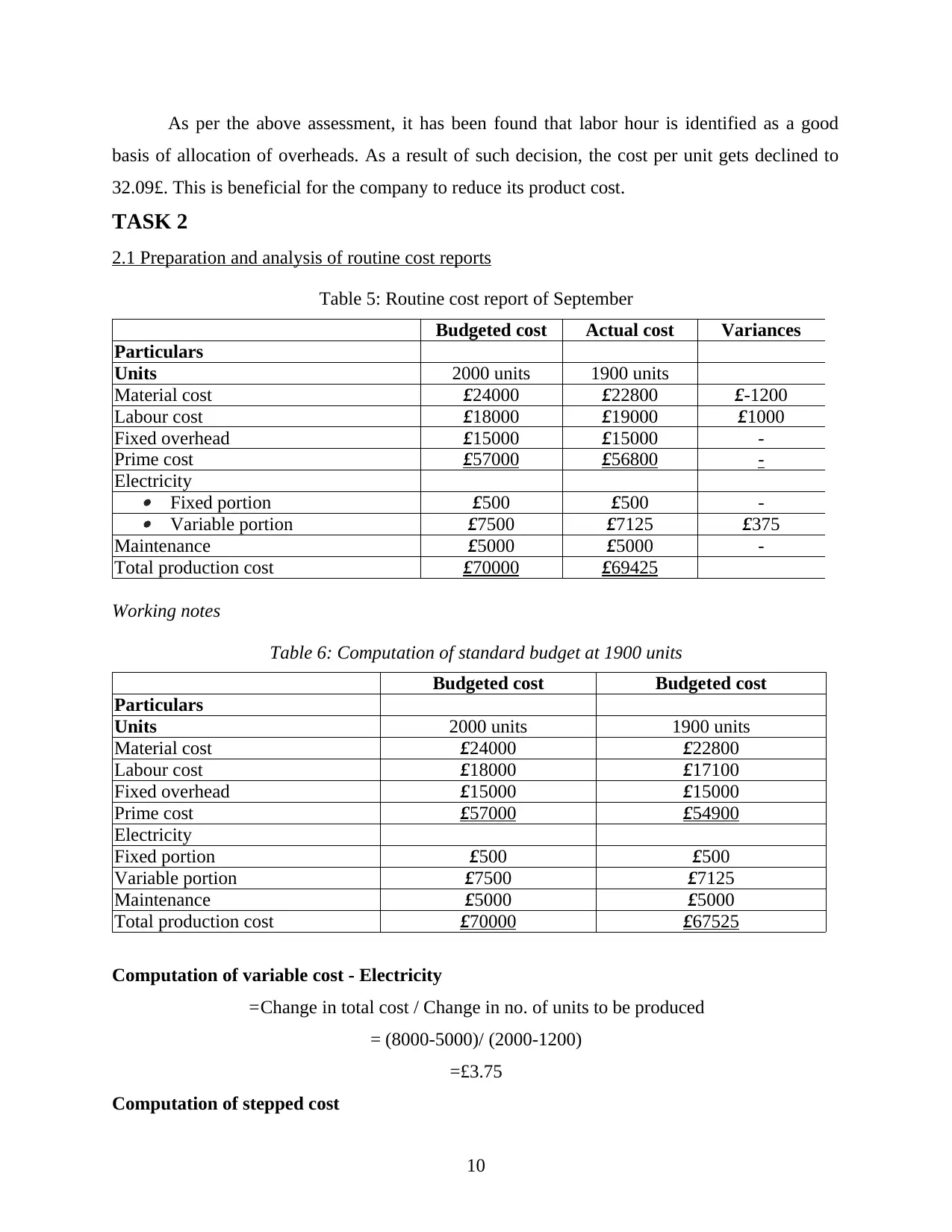
As per the above assessment, it has been found that labor hour is identified as a good
basis of allocation of overheads. As a result of such decision, the cost per unit gets declined to
32.09£. This is beneficial for the company to reduce its product cost.
TASK 2
2.1 Preparation and analysis of routine cost reports
Table 5: Routine cost report of September
Budgeted cost Actual cost Variances
Particulars
Units 2000 units 1900 units
Material cost £24000 £22800 £-1200
Labour cost £18000 £19000 £1000
Fixed overhead £15000 £15000 -
Prime cost £57000 £56800 -
Electricity
Fixed portion £500 £500 -
Variable portion £7500 £7125 £375
Maintenance £5000 £5000 -
Total production cost £70000 £69425
Working notes
Table 6: Computation of standard budget at 1900 units
Budgeted cost Budgeted cost
Particulars
Units 2000 units 1900 units
Material cost £24000 £22800
Labour cost £18000 £17100
Fixed overhead £15000 £15000
Prime cost £57000 £54900
Electricity
Fixed portion £500 £500
Variable portion £7500 £7125
Maintenance £5000 £5000
Total production cost £70000 £67525
Computation of variable cost - Electricity
=Change in total cost / Change in no. of units to be produced
= (8000-5000)/ (2000-1200)
=£3.75
Computation of stepped cost
10
basis of allocation of overheads. As a result of such decision, the cost per unit gets declined to
32.09£. This is beneficial for the company to reduce its product cost.
TASK 2
2.1 Preparation and analysis of routine cost reports
Table 5: Routine cost report of September
Budgeted cost Actual cost Variances
Particulars
Units 2000 units 1900 units
Material cost £24000 £22800 £-1200
Labour cost £18000 £19000 £1000
Fixed overhead £15000 £15000 -
Prime cost £57000 £56800 -
Electricity
Fixed portion £500 £500 -
Variable portion £7500 £7125 £375
Maintenance £5000 £5000 -
Total production cost £70000 £69425
Working notes
Table 6: Computation of standard budget at 1900 units
Budgeted cost Budgeted cost
Particulars
Units 2000 units 1900 units
Material cost £24000 £22800
Labour cost £18000 £17100
Fixed overhead £15000 £15000
Prime cost £57000 £54900
Electricity
Fixed portion £500 £500
Variable portion £7500 £7125
Maintenance £5000 £5000
Total production cost £70000 £67525
Computation of variable cost - Electricity
=Change in total cost / Change in no. of units to be produced
= (8000-5000)/ (2000-1200)
=£3.75
Computation of stepped cost
10
Paraphrase This Document
Need a fresh take? Get an instant paraphrase of this document with our AI Paraphraser
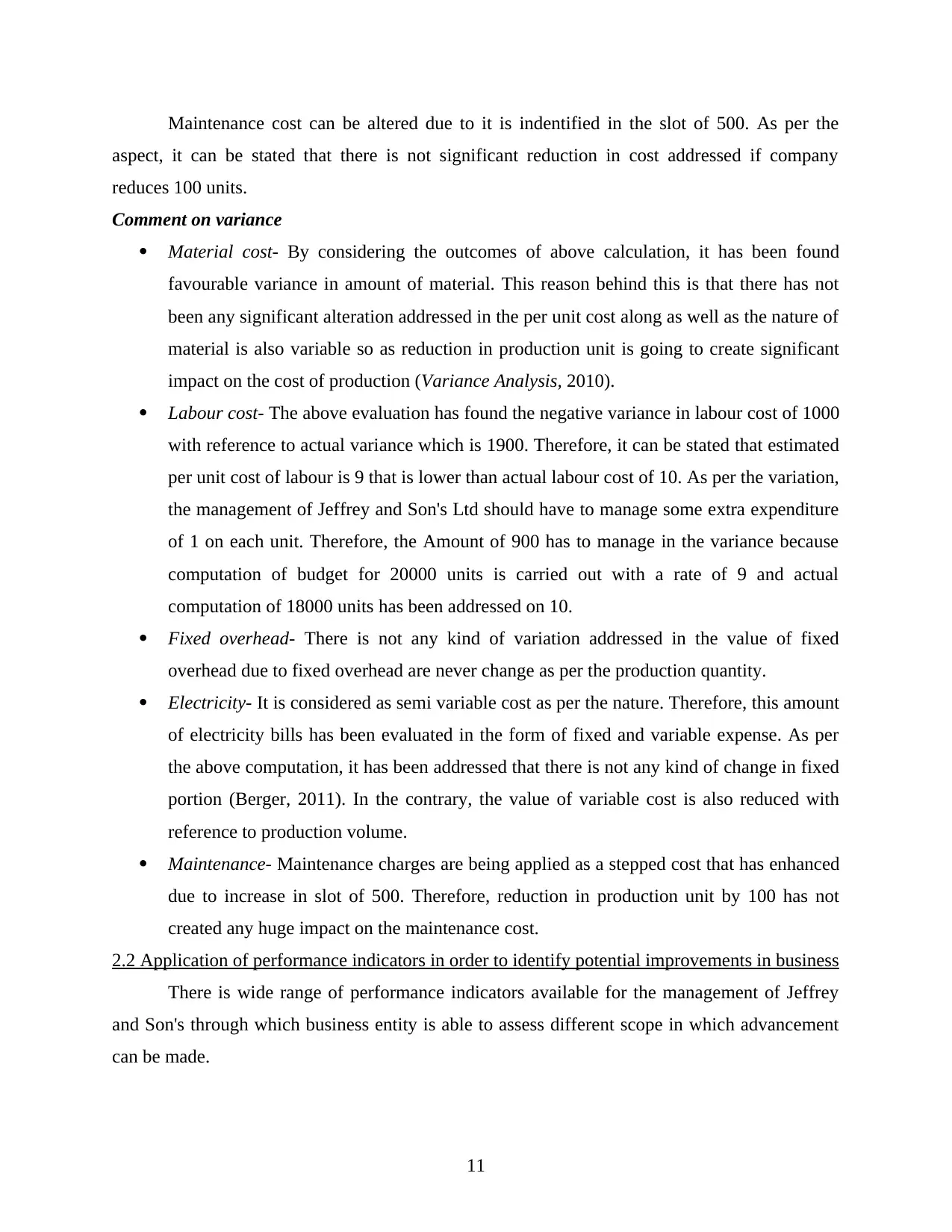
Maintenance cost can be altered due to it is indentified in the slot of 500. As per the
aspect, it can be stated that there is not significant reduction in cost addressed if company
reduces 100 units.
Comment on variance
Material cost- By considering the outcomes of above calculation, it has been found
favourable variance in amount of material. This reason behind this is that there has not
been any significant alteration addressed in the per unit cost along as well as the nature of
material is also variable so as reduction in production unit is going to create significant
impact on the cost of production (Variance Analysis, 2010).
Labour cost- The above evaluation has found the negative variance in labour cost of 1000
with reference to actual variance which is 1900. Therefore, it can be stated that estimated
per unit cost of labour is 9 that is lower than actual labour cost of 10. As per the variation,
the management of Jeffrey and Son's Ltd should have to manage some extra expenditure
of 1 on each unit. Therefore, the Amount of 900 has to manage in the variance because
computation of budget for 20000 units is carried out with a rate of 9 and actual
computation of 18000 units has been addressed on 10.
Fixed overhead- There is not any kind of variation addressed in the value of fixed
overhead due to fixed overhead are never change as per the production quantity.
Electricity- It is considered as semi variable cost as per the nature. Therefore, this amount
of electricity bills has been evaluated in the form of fixed and variable expense. As per
the above computation, it has been addressed that there is not any kind of change in fixed
portion (Berger, 2011). In the contrary, the value of variable cost is also reduced with
reference to production volume.
Maintenance- Maintenance charges are being applied as a stepped cost that has enhanced
due to increase in slot of 500. Therefore, reduction in production unit by 100 has not
created any huge impact on the maintenance cost.
2.2 Application of performance indicators in order to identify potential improvements in business
There is wide range of performance indicators available for the management of Jeffrey
and Son's through which business entity is able to assess different scope in which advancement
can be made.
11
aspect, it can be stated that there is not significant reduction in cost addressed if company
reduces 100 units.
Comment on variance
Material cost- By considering the outcomes of above calculation, it has been found
favourable variance in amount of material. This reason behind this is that there has not
been any significant alteration addressed in the per unit cost along as well as the nature of
material is also variable so as reduction in production unit is going to create significant
impact on the cost of production (Variance Analysis, 2010).
Labour cost- The above evaluation has found the negative variance in labour cost of 1000
with reference to actual variance which is 1900. Therefore, it can be stated that estimated
per unit cost of labour is 9 that is lower than actual labour cost of 10. As per the variation,
the management of Jeffrey and Son's Ltd should have to manage some extra expenditure
of 1 on each unit. Therefore, the Amount of 900 has to manage in the variance because
computation of budget for 20000 units is carried out with a rate of 9 and actual
computation of 18000 units has been addressed on 10.
Fixed overhead- There is not any kind of variation addressed in the value of fixed
overhead due to fixed overhead are never change as per the production quantity.
Electricity- It is considered as semi variable cost as per the nature. Therefore, this amount
of electricity bills has been evaluated in the form of fixed and variable expense. As per
the above computation, it has been addressed that there is not any kind of change in fixed
portion (Berger, 2011). In the contrary, the value of variable cost is also reduced with
reference to production volume.
Maintenance- Maintenance charges are being applied as a stepped cost that has enhanced
due to increase in slot of 500. Therefore, reduction in production unit by 100 has not
created any huge impact on the maintenance cost.
2.2 Application of performance indicators in order to identify potential improvements in business
There is wide range of performance indicators available for the management of Jeffrey
and Son's through which business entity is able to assess different scope in which advancement
can be made.
11
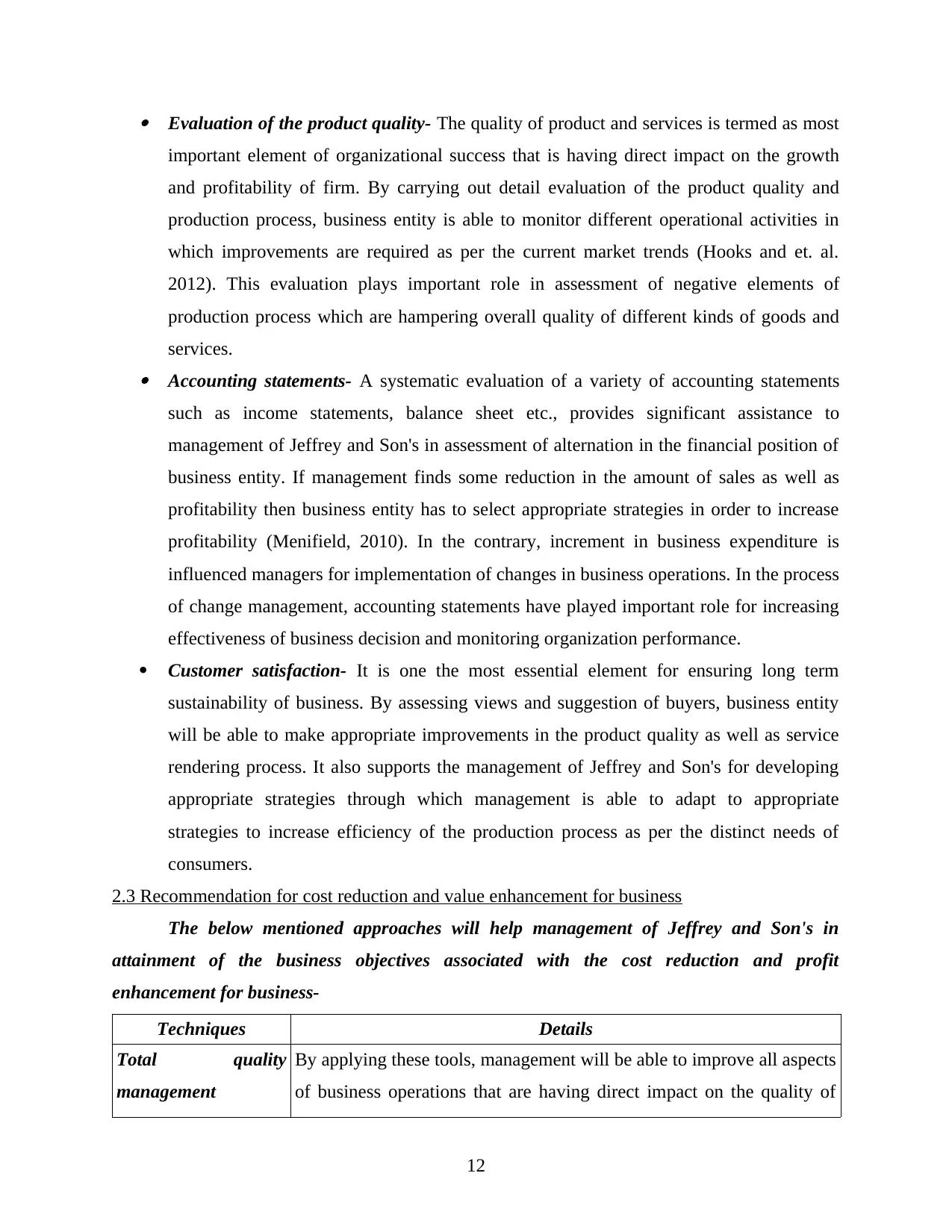
Evaluation of the product quality- The quality of product and services is termed as most
important element of organizational success that is having direct impact on the growth
and profitability of firm. By carrying out detail evaluation of the product quality and
production process, business entity is able to monitor different operational activities in
which improvements are required as per the current market trends (Hooks and et. al.
2012). This evaluation plays important role in assessment of negative elements of
production process which are hampering overall quality of different kinds of goods and
services. Accounting statements- A systematic evaluation of a variety of accounting statements
such as income statements, balance sheet etc., provides significant assistance to
management of Jeffrey and Son's in assessment of alternation in the financial position of
business entity. If management finds some reduction in the amount of sales as well as
profitability then business entity has to select appropriate strategies in order to increase
profitability (Menifield, 2010). In the contrary, increment in business expenditure is
influenced managers for implementation of changes in business operations. In the process
of change management, accounting statements have played important role for increasing
effectiveness of business decision and monitoring organization performance.
Customer satisfaction- It is one the most essential element for ensuring long term
sustainability of business. By assessing views and suggestion of buyers, business entity
will be able to make appropriate improvements in the product quality as well as service
rendering process. It also supports the management of Jeffrey and Son's for developing
appropriate strategies through which management is able to adapt to appropriate
strategies to increase efficiency of the production process as per the distinct needs of
consumers.
2.3 Recommendation for cost reduction and value enhancement for business
The below mentioned approaches will help management of Jeffrey and Son's in
attainment of the business objectives associated with the cost reduction and profit
enhancement for business-
Techniques Details
Total quality
management
By applying these tools, management will be able to improve all aspects
of business operations that are having direct impact on the quality of
12
important element of organizational success that is having direct impact on the growth
and profitability of firm. By carrying out detail evaluation of the product quality and
production process, business entity is able to monitor different operational activities in
which improvements are required as per the current market trends (Hooks and et. al.
2012). This evaluation plays important role in assessment of negative elements of
production process which are hampering overall quality of different kinds of goods and
services. Accounting statements- A systematic evaluation of a variety of accounting statements
such as income statements, balance sheet etc., provides significant assistance to
management of Jeffrey and Son's in assessment of alternation in the financial position of
business entity. If management finds some reduction in the amount of sales as well as
profitability then business entity has to select appropriate strategies in order to increase
profitability (Menifield, 2010). In the contrary, increment in business expenditure is
influenced managers for implementation of changes in business operations. In the process
of change management, accounting statements have played important role for increasing
effectiveness of business decision and monitoring organization performance.
Customer satisfaction- It is one the most essential element for ensuring long term
sustainability of business. By assessing views and suggestion of buyers, business entity
will be able to make appropriate improvements in the product quality as well as service
rendering process. It also supports the management of Jeffrey and Son's for developing
appropriate strategies through which management is able to adapt to appropriate
strategies to increase efficiency of the production process as per the distinct needs of
consumers.
2.3 Recommendation for cost reduction and value enhancement for business
The below mentioned approaches will help management of Jeffrey and Son's in
attainment of the business objectives associated with the cost reduction and profit
enhancement for business-
Techniques Details
Total quality
management
By applying these tools, management will be able to improve all aspects
of business operations that are having direct impact on the quality of
12
⊘ This is a preview!⊘
Do you want full access?
Subscribe today to unlock all pages.

Trusted by 1+ million students worldwide
1 out of 21
Related Documents
Your All-in-One AI-Powered Toolkit for Academic Success.
+13062052269
info@desklib.com
Available 24*7 on WhatsApp / Email
![[object Object]](/_next/static/media/star-bottom.7253800d.svg)
Unlock your academic potential
Copyright © 2020–2025 A2Z Services. All Rights Reserved. Developed and managed by ZUCOL.





